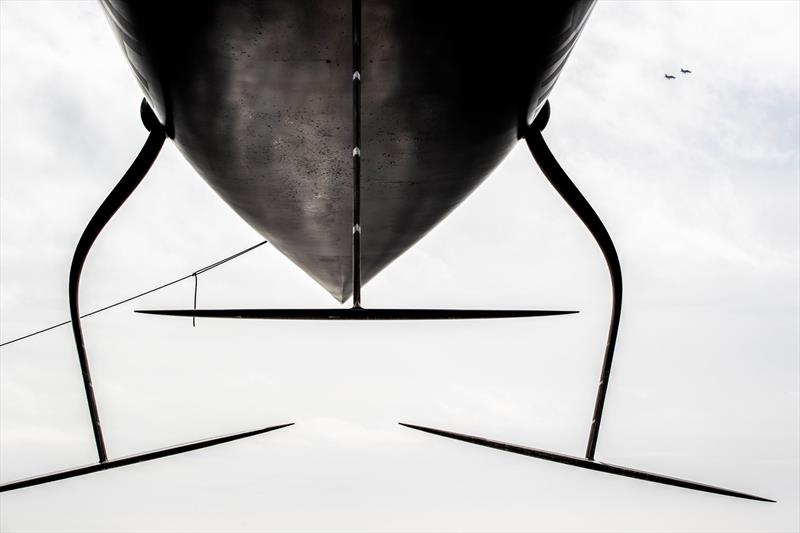
AC-75 class poised to rewrite America's Cup history
by David Schmidt 1 Oct 2019 16:00 BST
October 1, 2019

Foil configuration - American Magic © Amory Ross
If you're anything like me, you've now "wisely invested" significant parcels of time (obsessively) watching videos of the brand-new, AC-75 class yachts, which will be used to contest the 36th America's Cup (March 6-21, 2021), out flying above the water. Likewise, if you're anything like me, your reaction has involved your eyes and your jaw involuntarily opening and staying that way. Simply put, the "boats" just look fast. And while there's earnest debate whether these vessels resemble "boats" in the standard sense of the term, no one has questioned the class' potential to rewrite America's Cup history books.
Some backstory. When Emirates Team New Zealand bested Oracle Team USA to lift the Auld Mug on June 26, 2017, in a regatta that ended with a 7-1 scorecard, the consensus was clear that the Kiwis (and large percentages of the sailing public — not that the latter had a vote, of course) were interested in transitioning from the multihulls that were used to contest AC33, AC34 and AC35 into monohulls.
The twist, of course, is that these monohulls would fly on foils and would sail without a keel. Moreover, the boats would use a two-skinned "mainsail" that would shed significant weight aloft compared to the wingsails that powered the 72- and 50-foot multihulls that contested AC34 and AC35.
(Spend a moment and appreciate the complexities of trying to trim a two-skinned mainsail — it's a fun, albeit confusing, mental puzzle.)
To date, two teams - Defender Emirates Team New Zealand and the American-flagged challenger NYYC American Magic - have both launched their first-generation AC-75s, and future launches are expected shortly from Luna Rosa and INEOS Team UK. Moreover, ETNZ and American Magic boast radically different designs (pay attention to the yacht's bows and undercarriage sections), raising many questions about which team has built the better first-generation mousetrap.
While the level of technology involved in the AC-75 class, including the yacht's highly sophisticated flight-control systems (careful eyes will have spotted the Aerobus and Parker logos on the American-flagged yacht — there's a reason that aerospace companies are heavily involved in AC36), are mind-boggling, so too, is the concept of sailing a "monohull" without a keel. Even more intense is the fact that AC-75s fly their weather foil arm and T-shaped lifting foil well-clear of the brine.
Not only does this create a wild-looking aesthetic (imagine what Charlie Barr of Nathanael Greene Herreshoff would think of these yachts?), but it also potentially creates some serious objective hazards for the sailors and teams when the boats are put through their paces during the starting sequences (dial-ups, anyone?) and nautical chicanery that are sure to unfurl once AC36's starting guns begin sounding in earnest.
Now for the obvious question: exactly how fast are the new AC-75s? While we cannot divulge any secrets that we may or may not be privy to (ahem), I can say that based on the reports that I'm hearing from people in the know, the new boats have the potential to redefine speed as previously seen in the America's Cup. Here, of course, it's important to remember that boatspeed comparisons can be measured in absolute terms, or they can be measured in the amount of breeze required to get the boats up on foils, or how fast the boat is sailing relative to the true windspeed (amongst many other possible comparison points).
In all cases, based on what we may or may not have heard, we strongly suspect that sailors and audience members alike will be properly gob-smacked by the straight-line speed that the AC-75 class will exhibit.
But what about close and tactically challenging sailing? This is a hard one to answer based on the videos that are publicly available, as both teams that are flying their AC-75s are doing one-boat testing. Moreover, these first-generation boats just hit the water, meaning that the crews are still getting the boats up to pace and learning where their hard edges are lurking.
So, while publishable facts or videos showing two-boat testing are presently elusive, the simple fact that these boats now exist and work as advertised is hugely impressive and bodes well for what AC36 may hold in store for the sailing-obsessed public come March of 2021. Granted, AC36 would be a much better regatta if more teams were competing, but even with a projected four-team regatta, hopefully the AC-75 designs will deliver the kind of white-knuckled racing that defined the last two America's Cups.
Sail-World.com wishes all teams good luck as they prepare for a regatta that promises to be one for the history books.
May the four winds blow you safely home,
David Schmidt
Sail-World.com North American Editor